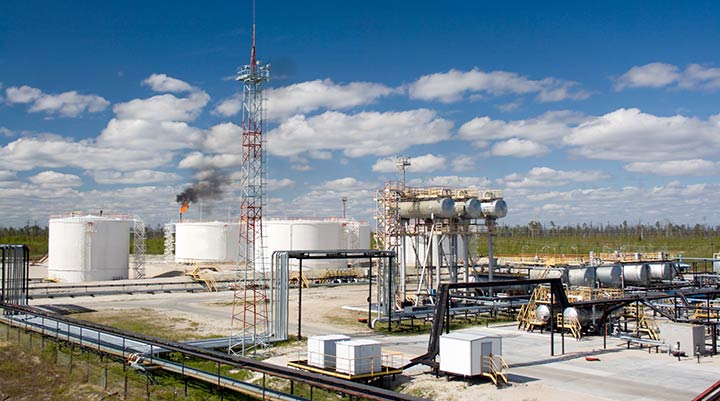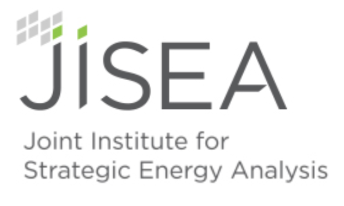JISEA-Supported Analysis Helps Close the Gap in Inventories for Emissions From U.S. Oil and Natural Gas Production

Inventories of methane emissions from oil and natural gas production are critical for policy design, cost analysis, programs to detect and repair leaks, and more. Photo from iStock
August 5, 2021—Methane, a primary constituent of natural gas, can intentionally or unintentionally be emitted into the air during oil and natural gas production.
The U.S. Environmental Protection Agency estimates methane emissions from oil and natural gas production in its annual Greenhouse Gas Inventory. The inventory is used to better understand total emissions and sources and develop mitigation policy for methane emissions.
However, the Greenhouse Gas Inventory has consistently been found to be low compared to site-level field measurements.
"Government agencies, environmental groups, and researchers rely on inventory data for policy design, cost analysis, formulation of leak detection and repair programs, and life-cycle assessment research," said JISEA analyst and sustainability expert Garvin Heath. "Accurate inventories are critical."
To help close the gap in methane emissions inventories, Heath and researchers at JISEA's partners, Stanford University and Colorado State University, as well as Harrisburg University of Science and Technology, California Air Resources Board, and Environmental Defense Fund, developed a new statistical approach to more accurately estimate emissions from oil and natural gas production—outlined in a Nature Communications article.
A New Bottom-Up Approach
The analysts developed a bottom-up, component-level approach to estimate emissions at the most detailed level (the bottom) and scale up.
The approach uses data from the most comprehensive database of component-level, publicly available direct emissions measurements of the oil and natural gas production sector that's ever been compiled—totaling nearly 3,700 measurements. The component-level data is used to generate equipment-level emission estimates. The approach then resamples the data 100 times to generate an overall methane emissions estimate with a 95% confidence level.
"The component-level data is really the key difference in our approach," Heath said. "It allows us to diagnose differences in inventories at the equipment level, which has never previously been done."
How Do Estimates Compare to Site-Level Studies and the Greenhouse Gas Inventory?
The team of analysts tested their estimating approach on 2015 U.S. oil and natural gas production methane emissions. The approach calculated 1.3% methane emissions for 2015—just slightly lower than 1.5% in site-level studies. Both estimates are twice the 2015 levels reported by the Greenhouse Gas Inventory.
Emissions from equipment leaks and venting from storage tanks stood out as the biggest gap in estimates between the new approach and the Greenhouse Gas Inventory. The new approach estimated higher emissions from equipment leaks and tanks, contributing over half of total methane emissions from oil and natural gas production in 2015.
Why Are Estimates Lower in the Greenhouse Gas Inventory?
Differences in estimates come down to the data sources, the analysts determined. The new approach uses a larger dataset with more recent measurements that more accurately represent today's conditions and have higher resolution and fidelity to the measured distributions.
The Greenhouse Gas Inventory calculates component-level emissions from a dataset of various facilities like oil and gas production sites or refineries. There could be sampling bias in the original collection process or fundamental differences in the populations sampled. In addition, equipment-level estimates in the Greenhouse Gas Inventory are weighted with data from small studies in the 1990s.
To determine emissions from storage tanks, the Greenhouse Gas Inventory uses measurements from simulations rather than direct measurements like the new approach. "We believe incorporating a larger emissions dataset and using the bottom-up modeling approach for unintentional sources of emissions like storage tanks has produced a much more accurate inventory of methane emissions," Heath said.
Results from the study can be used as inputs in emission databases worldwide and points to specific areas and approaches to improve the Greenhouse Gas Inventory.
More JISEA Work in Air Quality and Atmospheric Systems
The study on methane emissions from oil and natural gas production falls under JISEA's Energy and Atmospheric Systems Catalyzer.
Launched earlier this year, the JISEA Catalyzers initiative brings together experts in specific research topics to incubate a new program in 1–2 years. Heath is the co-principal investigator of the Energy and Atmospheric Systems Catalyzer—one of the two inaugural catalyzers—exploring multidirectional relationships across climate, air quality, and energy systems.
Learn more about the Energy and Atmospheric Systems Catalyzer.
Back to JISEA News >
